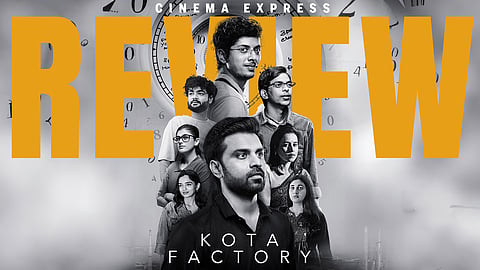Kota Factory Season 3 Review: Jitendra Kumar tries but emotional resonance stays out of syllabus this time around
Kota Factory Season 3(2.5 / 5)
A seed is sown, it germinates into a plant and a fruit ripens. For a fleeting moment, there is a natural sweetness that it carries and that slowly turns stale; a fragrance that remains pleasant until it withers away. The three seasons of TVF’s Kota Factory are synonymous with this process. In its nascent stage, the first season began with an alluring seed that seamlessly bore flavourful fruits by the end. It gave a promising look into the complex and burdensome world of competitive exams through a natural blend of wit and emotion. Telling the story of such a colourless world from a monochromatic lens carried the burden of being too literal, yet it brought in a comforting breeze. As it was renewed for the second season, the ripeness was no longer as extraordinary. Signs of staleness started protruding as it didn’t know what more to do with its worldbuilding. Season 3 is an extension of the same as it feels completely devoid of that early fragrance, meandering and struggling to sow the seed again.
We meet Vaibhav (Mayur More), Uday (Alam Khan) and Meena (Ranjan Raj) head on in the early minutes of the first episode as they have an encounter with another student, who makes fun of them when they ask him a question from a recent test they couldn’t solve. It begins rather straightforwardly without a memorable opening. It's neither powerfully understated nor it gives you a captivating plunge into future events. Something seems amiss. There is a perpetual effort to introduce conflicts, and we get the very first in the form of Vaibhav’s cricketer cousin who comes to stay with him for a day, impressing his friends while leaving him in bouts of jealousy and rage. Meanwhile, the traumatic events at the end of Season 2 have had a great toll on Jeetu Bhaiya (Jitendra Kumar) as he struggles to get back to normalcy and return to teaching. He seeks therapy to feel better and finally returns to give a pep talk to Vaibhav while battling his own inner demons.
Director: Pratish Mehta
Starring: Jitendra Kumar, Mayur More, Alam Khan, Ranjan Raj, Ahsaas Channa, Revathy Pillai, Tillotama Shome and Urvi Singh
Streamer: Netflix
The evolution of Jeetu Bhaiya from a myth to an emotional being has been interesting. He is no longer just a saintly figure who has all the answers. We see him struggle as he questions his own beliefs and gets cramped under its burden. His progression in vulnerability is among the strongest links in the show, yet it is not given the kind of exploration it deserves. Instead, writers, Puneet Batra, Pravin Yadav, Manish Chandwani and Nikita Lalwani infuse the show with rapid unfolding; there is little thehraav. Jeetu’s struggles are reflected in the damp spoilage that develops in a corner of his house, similar to the emotional block that he faces in his mind. It could have been a smart device if it was not too literal. The poetry in the metaphor is lost by delving into it more than necessary. It becomes a centrepiece rather than an underlining moment as it should have been, making the show lose out on a crucial moment early on.
The problems don’t end there. Certain scenes are unnecessarily stretched when there’s little action happening in them. Even the montages of the characters studying or giving exams feel misplaced. We have seen why Jeetu Bhaiya is loved by the students through numerous instances in the last two seasons, yet when the therapist asks him why is he called ‘Jeetu Bhaiya’, a long explanation follows. The fact that Kota is a factory where students are mass-manufactured is something which the show has been building upon since season 1, both visually and otherwise. Yet, Tillotama Shome’s character is given detailed lines explaining why it is a bad place. After a point, it gets tiresome to witness as there is nothing significant to add in the themes except perhaps how Jeetu battles to keep boundaries with his students as his mental health deteriorates. There is an instant loss of universality when we repeatedly hear concepts from physics and chemistry along with the finer intricacies of the JEE exams without subsequent emotional resonance with the characters. The filmmaking is in two minds as sometimes it critiques the flawed system but also partakes occasionally in the romanticism of ‘struggle’ which is forced upon the students. Yes, an inspirational song about not giving up plays over slow-motion visuals.
The sense of rhythm is also lost. The performances occasionally fall flat, and the constant background score seems to compensate for the lack of emotional resonance. The usually charming Alam Khan is tedious to watch here as he feels less like a natural character and more like a narrative device used when convenient. His one-liners no longer elicit laughter as they add nothing new to what we already know. The same is true for Mayur, who feels inconsistent, either overly grumpy or launching into long, hysterical monologues that seem to be a forced callback to a more genuine sequence in Season 1. All of this is due to the shortcomings in direction and a lack of nuance in writing, which makes an insufficient use of the energies of actors. Jeetendra Kumar battles this as he gets to essay a character who has the most layers, and he brings an earnest appeal to his performance. It is through smaller moments of fumbling, heavy breathing and furtive eye glances that he manages to win us over. Tillotama as the chemistry teacher, plays a grossly underwritten role that has no arc but only some instances of prominence spread around in a couple of episodes.
Third time’s usually a charm but not here. The show tries to get itself together towards the end with an interplay of sentimentality, which strikes a minor chord. It is a dramatic end that falls short of becoming a symphony because of the ordinary storytelling that precedes it. I was left with a longing to participate in the climactic glory, but it wasn’t completely satisfying to withhold. The law of conservation of energy states that it can neither be created nor destroyed. But here, it has clearly failed to get converted from one form to another.


